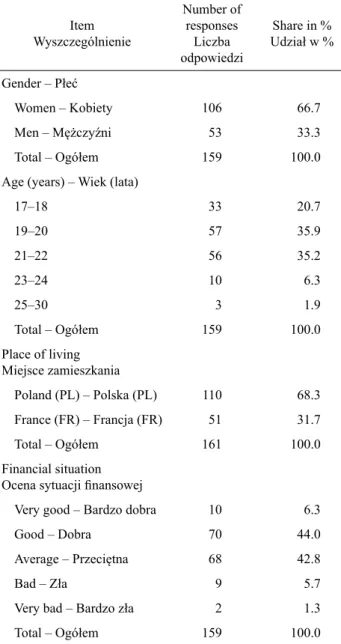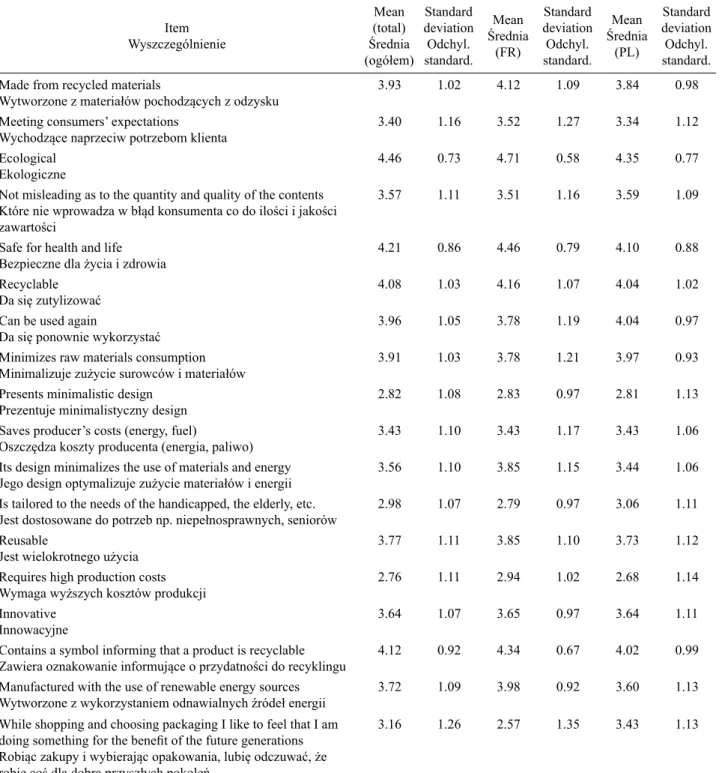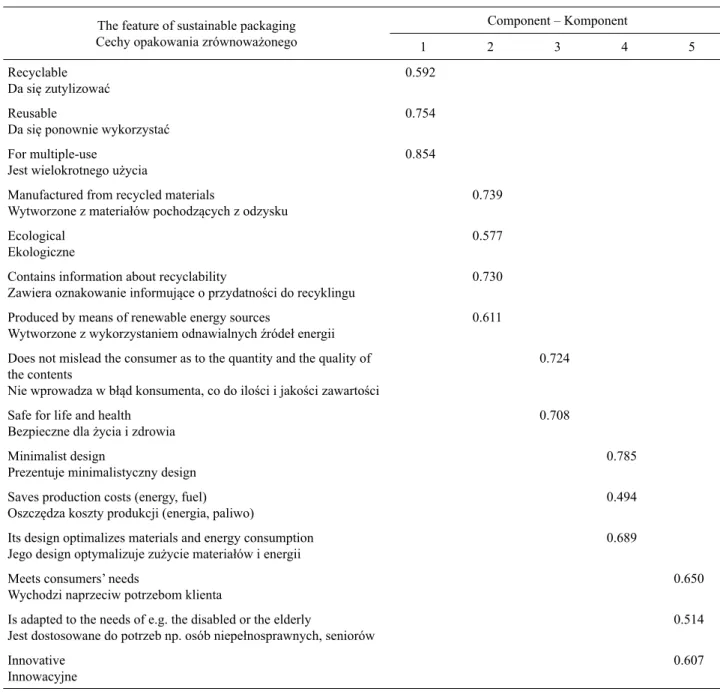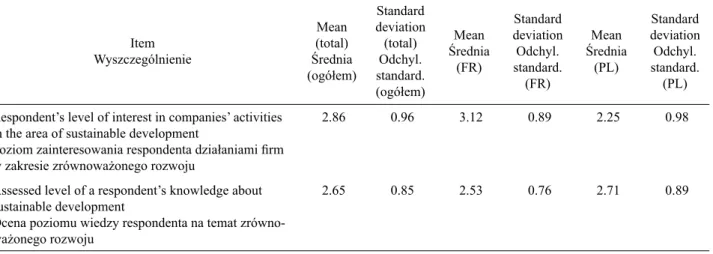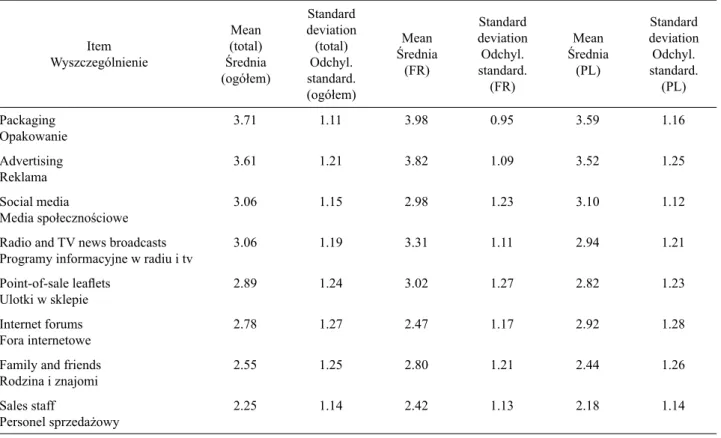pISSN 1899-5241 eISSN 1899-5772
3(37) 2015, 437–445
dr hab. Ewa Jerzyk, prof. nadzw. UEP, Katedra Strategii Marketingowych, Uniwersytet Ekonomiczny w Poznaniu, al. Niepod-Abstract. The promotion of the idea of sustainable
devel-opment largely depends on the way it is perceived and un-derstood by consumers. Therefore, the article presents the fi ndings of a survey on consumers’ knowledge about sustain-able packaging, in particularŚ the understanding of the idea of sustainable packaging in terms of sustainable development, consumers’ interest in the concept of sustainable packaging, as well as the sources of information about sustainable pack-aging. Numerous earlier studies showed that younger and better-educated consumers are more favourably disposed to this concept, so the research was restricted to young consum-ers. The respondents’ opinions were analysed from the point of view of the purchase decision process. The subject of the analysis was the signifi cance of particular characteristics of sustainable packaging for consumers. The research allowed for establishing fi ve characteristics of sustainable packaging which, according to the respondents, are the main criteria for the assessment and the comparison of products and packag-ing durpackag-ing shopppackag-ing. Moreover, it turned out that in mature markets consumers display higher sensitivity to companies’ sustainable activities, including those related to packaging, which can be caused by the economic reasons (consumers are not very price-conscious).
Key words: sustainable packaging, buying behaviour,
sus-tainable corporate activity
INTRODUCTION
A number of companies presently undertake activities for the sake of the protection of the environment, taking into account a growing segment of socially responsible consumers who want to buy fewer products which nega-tively affect the environment and the quality of life of the future generations. Sustainable development does not merely result from the źU directives or the legislation, but it has become good business practice, supported by the growing number of well-educated consumers and it can be a source of the competitive advantage. Therefore, what can be observed now is a kind of a race for being the fi rst to create and promote rules and procedures of what can be regarded as sustainable and more competitive than things not having these qualities (źttenson, 2Ńń4). One of the areas of such intensive activity is the fi eld of packaging. Recent years have seen numerous new estab-lishments in the area of sustainable packaging, but also brought increasing dilemmas of consumers, who are not always sure what is and what is not sustainable packag-ing (Scherer, 2Ńń2). Some packages are misleadpackag-ing be-cause of the incomplete or imprecise information they contain, making the comparison of products even less comfortable for consumers. If a consumer does not have a possibility of an objective comparison of products and brands, in terms of their infl uence on the environment,
SUSTAINABLE PACKAGING AS A
DETERMINANT
OF
THE
PROCESS OF MAKING PURCHASE DECISIONS
FROM THE PERSPECTIVE OF POLISH AND FRENCH
YOUNG CONSUMERS
Ewa Jerzyk
they can easily become subject to manipulation. Com-panies building their competitive advantage at the level of their sustainable packaging are in the dark, uncertain of what kind of information is expected by consumers and to what degree they are involved in the sustainable consumption, as well as in what way they should inform consumers about their activities related to sustainable development.
SUSTAINABLE PACKAGING
IN THE CONCEPT OF SUSTAINABLE DEVELOPMENT
Sustainable development, often regarded as a challenge of the 2ńst century, is related to the concept of con-tinuous economic growth, accompanied by the respect for natural resources and the protection of the natural environment, for the benefi t of the present and future generations (Lisi ska-Ku nierz, 2ŃńŃś Kiełczewski, 2ŃŃ8ś Przychodze , 2Ńń3ś Sztumski, 2ŃŃ6). The imple-mentation of this concept at the microeconomic level is strongly linked to packaging, which can play an impor-tant role in both the sustainable development of a com-pany and building competitive advantage. Packaging as a part of the sustainable development of a company takes the form of sustainable packaging. It is assumed that the infl uence of sustainable packaging on consum-ers’ behaviour will have positive economic, social and ecological results. In addition, it will contribute to the well-being of the future generations.
Sustainable packaging is hard to defi ne and to measure (Sonneveld et al., 2ŃŃ5ś Verghese et al., 2Ńń2ś Lisi ska-Ku nierz, 2ŃńŃ). In an attempt to defi ne sus-tainable packaging, researchers often refer to the fi nd-ings of the Sustainable Packaging Alliance (SPA) of 2ŃŃ2 (effective, effi cient, cyclic, safe), or the Sustain-able Packaging Coalition (SPC) of 2ŃŃ5, according to which packaging is supposed to meet the following criteriaŚ
• is benefi cial and safe for consumers and the society throughout its whole lifecycle,
• meets the requirements related to effi ciency and costs,
• its origin, production, transport and recycling are carried out with the use of renewable energy sources, • optimalizes the use of raw materials,
• is produced by means of clean technology and best practice,
• is made of environmentally friendly materials at each stage of its lifecycle,
• its design optimalizes the consumption of energy and materials,
• is effectively recycled and utilized in closed biologi-cal and industrial systems.
Presently a number of companies (e.g. Tesco, Walmart, McŹonald’s, Carlsberg, Unilever) undertake activities aiming to establish the characteristics of sus-tainable packaging (Verghese et al., 2Ńń2ś Sussus-tainable..., n.d.ś Commitment..., n.d.).
Considering the signifi cance of packaging for the sustainable development concept, its role should be seen in the following dimensions (Hanss i Böhm, 2Ńń2, COBRO)Ś
• the environment (saving its resources, responsible use of non-renewable resources, limiting the nega-tive infl uence of packaging on the environment throughout its whole lifecycle, the use of renewable resources, controlling the greenhouse gases emission at particular stages of its lifecycle, voluntary certifi -cation in terms of the ecological criteria)ś
• the society (packaging should guarantee reasonable quality of life, take care of the functioning condi-tions of the society, meet consumers’ expectacondi-tions, support consumers’ education and improve the state of knowledge about solutions benefi cial for both the environment and the societyś
• economy (packaging should reduce the production, transportation and utilization costs)ś
• time (they should take care of the needs of both the present and the future generations)ś
• development (packaging should foster innovation and development of companies).
RESEARCH METHODOLOGY
The research was conducted by means of an auditorium questionnaire among ń6ń young consumers from Po-land and Żrance, from the age group ń7–3Ń (Table ń). The majority of them were students who declared doing shopping for themselves and their households. It was assumed that better-educated and younger consumers should be more aware of the environmental issues and their behavior should be considerate and ethical, i.e. in the selection of products and services they are not only economically motivated, but also take into account eco-logical, social and ethical aspects (Źąbrowska, 2ŃŃń). Over half of the respondents declared that they were responsible for at least 3Ń% of the overall amount of shopping for their households. Therefore, it could be presumed that the respondents had a good knowledge of the market and were experienced in the everyday shop-ping. The research included consumers from Poland and from Żrance, in order to fi nd out to what degree the eco-logical awareness and the knowledge about sustainable consumption and sustainable packaging depends on the level of economic development and the market maturity.
RESEARCH FINDINGS
In the survey the respondents were asked if they had previously encountered the term “sustainable packag-ing”. Over 4Ń% of the respondents were familiar with the term, the remaining ones chose either the answer “no” (26.ń%), or “hard to say” (3Ń.4%). The analy-sis of the fi ndings based on the respondents’ country showed a considerable discrepancy between the Polish and Żrench consumers (Żig. ń). The Żrench consumers turned out to be more knowledgeable than the Polish ones. A considerable majority (7ń.4%) of the Żrench re-spondents declared that they had previously heard the term sustainable packaging. Only 3Ń% of the Polish re-spondents gave the same response.
The respondents were presented with ń8 expressions related to sustainable packaging and were asked to spec-ify if they agreed with them. The scale of the opinions ranged from 5 to ń, where 5 meant “defi nitely yes” and ń – “defi nitely no”. Afterwards the mean values were calculated (Table 2). Their analysis allowed for drawing a few interesting conclusions. Żirstly, in the respondents’ opinion, the factor determining whether or not packag-ing is sustainable is its ecological value. Although they
Table 1. Structure of respondents participating in the research Tabela 1. Struktura respondentów uczestniczących w badaniu
Item Wyszczególnienie
Number of responses
Liczba odpowiedzi
Share in % Udział w %
żender – Płeć
Women – Kobiety ńŃ6 66.7
Men – Mę czy ni 53 33.3
Total – Ogółem ń59 ńŃŃ.Ń Age (years) – Wiek (lata)
ń7–ń8 33 2Ń.7
ń9–2Ń 57 35.9
2ń–22 56 35.2
23–24 ńŃ 6.3
25–3Ń 3 ń.9
Total – Ogółem ń59 ńŃŃ.Ń Place of living
Miejsce zamieszkania
Poland (PL) – Polska (PL) ńńŃ 68.3 Żrance (ŻR) – Żrancja (ŻR) 5ń 3ń.7 Total – Ogółem ń6ń ńŃŃ.Ń Żinancial situation
Ocena sytuacji fi nansowej
Very good – Bardzo dobra ńŃ 6.3
żood – Źobra 7Ń 44.Ń
Average – Przeciętna 68 42.8
Bad – Zła 9 5.7
Very bad – Bardzo zła 2 ń.3 Total – Ogółem ń59 ńŃŃ.Ń
In the case of the two questionnaires were lack of information (gender, age, assessment fi nancial situation) and they are there-fore left out in the analysis using these variables).
SourceŚ own elaboration based on a survey.
W przypadku dwóch ankiet wystąpiły braki informacji (płeć, wiek, ocena sytuacji fi nansowej) i dlatego zostały one pominięte w analizie z wykorzystaniem tych zmiennych).
Table 2. Perception of sustainable packaging – mean values
Tabela 2. Postrzeganie opakowania zrównowa onego – warto ci rednie
Item Wyszczególnienie
Mean (total) rednia (ogółem)
Standard deviation Odchyl. standard.
Mean rednia (ŻR)
Standard deviation Odchyl. standard.
Mean rednia (PL)
Standard deviation Odchyl. standard. Made from recycled materials
Wytworzone z materiałów pochodzących z odzysku 3.93 ń.Ń2 4.ń2 ń.Ń9 3.84 Ń.98 Meeting consumers’ expectations
Wychodzące naprzeciw potrzebom klienta 3.4Ń ń.ń6 3.52 ń.27 3.34 ń.ń2 źcological
źkologiczne 4.46 Ń.73 4.7ń Ń.58 4.35 Ń.77
Not misleading as to the quantity and quality of the contents Które nie wprowadza w błąd konsumenta co do ilo ci i jako ci zawarto ci
3.57 ń.ńń 3.5ń ń.ń6 3.59 ń.Ń9
Safe for health and life
Bezpieczne dla ycia i zdrowia 4.2ń Ń.86 4.46 Ń.79 4.ńŃ Ń.88 Recyclable
Źa się zutylizować 4.Ń8 ń.Ń3 4.ń6 ń.Ń7 4.Ń4 ń.Ń2
Can be used again
Źa się ponownie wykorzystać 3.96 ń.Ń5 3.78 ń.ń9 4.Ń4 Ń.97 Minimizes raw materials consumption
Minimalizuje zu ycie surowców i materiałów 3.9ń ń.Ń3 3.78 ń.2ń 3.97 Ń.93 Presents minimalistic design
Prezentuje minimalistyczny design 2.82 ń.Ń8 2.83 Ń.97 2.8ń ń.ń3 Saves producer’s costs (energy, fuel)
Oszczędza koszty producenta (energia, paliwo) 3.43 ń.ńŃ 3.43 ń.ń7 3.43 ń.Ń6 Its design minimalizes the use of materials and energy
Jego design optymalizuje zu ycie materiałów i energii 3.56 ń.ńŃ 3.85 ń.ń5 3.44 ń.Ń6 Is tailored to the needs of the handicapped, the elderly, etc.
Jest dostosowane do potrzeb np. niepełnosprawnych, seniorów 2.98 ń.Ń7 2.79 Ń.97 3.Ń6 ń.ńń Reusable
Jest wielokrotnego u ycia 3.77 ń.ńń 3.85 ń.ńŃ 3.73 ń.ń2 Requires high production costs
Wymaga wy szych kosztów produkcji 2.76 ń.ńń 2.94 ń.Ń2 2.68 ń.ń4 Innovative
Innowacyjne 3.64 ń.Ń7 3.65 Ń.97 3.64 ń.ńń
Contains a symbol informing that a product is recyclable
Zawiera oznakowanie informujące o przydatno ci do recyklingu 4.ń2 Ń.92 4.34 Ń.67 4.Ń2 Ń.99 Manufactured with the use of renewable energy sources
Wytworzone z wykorzystaniem odnawialnych ródeł energii 3.72 ń.Ń9 3.98 Ń.92 3.6Ń ń.ń3 While shopping and choosing packaging I like to feel that I am
doing something for the benefi t of the future generations Robiąc zakupy i wybierając opakowania, lubię odczuwać, e robię co dla dobra przyszłych pokole
3.ń6 ń.26 2.57 ń.35 3.43 ń.ń3
The scale of opinions was from ń – defi nitely not, to 5 – defi nitely yes. SourceŚ own elaboration based on survey fi ndings.
can be expected to have a big problem with defi ning ecological packaging, the survey results make it clear that this is an important issue for the respondents. They expect an explicit clue as to which packaging can be regarded as ecological. Therefore, most probably a pro-ducer who will use such an argument in their market-ing campaign will gain competitive advantage. Another interesting fact is the high mean value of the response “Safe for health and life”. The respondents may feel threatened by the producers’ freedom in selecting pack-aging, which may pose a threat to consumers’ health or life. It may mean that consumers possibly put a lot of weight on the safety certifi cates of the materials used in packaging and also the packaging form. Another impor-tant feature of sustainable packaging is its recyclebility, which is a valid conclusion, particularly for the Polish consumers, after the introduction of the revised Munici-pal Waste Act of 2Ńń3.
The biggest discrepancies between the mean values for the Polish and Żrench respondents appeared in the following areasŚ
• the needs of the future generations (selecting pack-aging I like to feel that I am doing something for the benefi t of the future generations) – the Żrench respondents had higher values,
• the packaging design, which minimizes the use of materials and energy – higher values among the Pol-ish respondents,
• the production of packaging with the use of renew-able energy sources – higher values among the Pol-ish respondents.
The factor analysis allowed for obtaining a general synthetic picture of what sustainable packaging is for the respondents. Cronbach’s alpha coeffi cient was used and KMO (Peterson, ń994, Rószkiewicz, 2Ńńń). The value of the Alfa Cronbach coeffi cient was reckoned as Ń.786 and KMO – Ń.768. The conducted analysis showed that for young consumers sustainable packaging has fi ve main attributes, which account for 59% of the variability (Table 3). These areŚ reusability, recycling, honesty and safety, economical use of raw materials and adaptability to the consumers’ needs.
The fi rst attribute is related to the possibility of a multiple use of sustainable packaging. In the respond-ents’ opinion if a packaging is reusable, it is sustainable. The conducted research does not give us a defi nite an-swer to the question whether or not consumers would be ready to pay more to cover the cost of such packaging. However, the multiple use factor plays an important role for them. The next factor describes sustainable packag-ing as ecological, recyclable and conveypackag-ing a clear mes-sage about this fact to the consumer. The third factor refers to honesty and safety of sustainable packaging. Young consumers identify sustainable packaging with the economical use of raw materials, emphasizing the role of minimalist design of such packaging. Its last attribute is functionality, which involves meeting the needs of all consumers, including those who are often neglected – the elderly and the disabled.
With reference to the basic elements of the sus-tainable development concept – environment, society, economy, future (time) and development – the results of the factor analysis show that young consumers per-ceive sustainable packaging mainly in terms of the se-curity of the environmentŚ the protection and sustaining of the natural resources (the fi rst and the second factor). The third factor can be related to the question of values, which can be ascribed to the social context of the sus-tainable development, the next factor – to the economic
30
36.4
33.6 71.4
4.1
24.5
0 10 20 30 40 50 60 70 80
yes
tak nieno WUXGQRSRZLHG]LHühard to say
(%)
PL FR
Fig. 1. Knowledge of the term “sustainable packaging” of
respondents
SourceŚ own elaboration based on a survey.
Rys. 1. Znajomo ć terminu „zrównowa one opakowanie”
w ród respondentów
dimension and the last one – to the development which allows for solving the problems of the consumers who so far have been neglected in companies’ activities.
The sustainable packaging factor has a medium sig-nifi cance for young consumers from Poland and Żrance
in making their buying decisions (the level of the aver-age assessments was 2.47 (standard deviation Ń.94) and 2.5Ń (standard deviation Ń.98) in the scale from ń to 5, where ń meant “irrelevant” and 5 “defi nitely relevant”. It can be expected that such responses are not very
Table 3. Sustainable packaging from the perspective of young consumers (the factor analysis) Tabela 3. Opakowanie zrównowa one z perspektywy młodych konsumentów (analiza czynnikowa)
The feature of sustainable packaging Cechy opakowania zrównowa onego
Component – Komponent
ń 2 3 4 5
Recyclable
Źa się zutylizować Ń.592
Reusable
Źa się ponownie wykorzystać Ń.754 Żor multiple-use
Jest wielokrotnego u ycia Ń.854
Manufactured from recycled materials
Wytworzone z materiałów pochodzących z odzysku Ń.739 źcological
źkologiczne Ń.577
Contains information about recyclability
Zawiera oznakowanie informujące o przydatno ci do recyklingu Ń.73Ń Produced by means of renewable energy sources
Wytworzone z wykorzystaniem odnawialnych ródeł energii Ń.6ńń Źoes not mislead the consumer as to the quantity and the quality of
the contents
Nie wprowadza w błąd konsumenta, co do ilo ci i jako ci zawarto ci
Ń.724
Safe for life and health
Bezpieczne dla ycia i zdrowia Ń.7Ń8
Minimalist design
Prezentuje minimalistyczny design Ń.785
Saves production costs (energy, fuel)
Oszczędza koszty produkcji (energia, paliwo) Ń.494 Its design optimalizes materials and energy consumption
Jego design optymalizuje zu ycie materiałów i energii Ń.689 Meets consumers’ needs
Wychodzi naprzeciw potrzebom klienta Ń.65Ń
Is adapted to the needs of e.g. the disabled or the elderly
Jest dostosowane do potrzeb np. osób niepełnosprawnych, seniorów Ń.5ń4 Innovative
Innowacyjne Ń.6Ń7
SourceŚ own elaboration based on survey results.
remote from those which are normally diagnosed in defi ning the role of packaging in the shopping process. It can be explained by the fact that in declarative surveys consumers often omit the signifi cance of packaging in their purchase decisions (Jerzyk, 2Ńń4b).
The analysis of the research on the respondents’ in-terest, companies activities in the area of sustainable development, as well as the respondents’ knowledge al-lowed us to draw an interesting conclusion. It appeared that the respondents’ stronger interest in such activity does not mean that they have a broader knowledge in this respect (Table 4). This conclusion was particularly valid in relation to the respondents from Żrance. These fi ndings lead to the conclusion that either companies do not effectively communicate with consumers about sustainable activities, or they do not communicate with them about it at all. On the other hand, it is noticeable that consumers from mature markets are interested in receiving this type of information.
Żor young Żrench and Polish consumers the most de-sirable sources of information were packaging and TV commercials, as well as radio and TV news broadcasts (Table 5). Moreover, the Poles appreciated social media, whereas the Żrench – news broadcasts and point-of-sale leafl ets and bulletins.
CONCLUSIONS
The research showed that in mature markets consumers reveal higher sensitivity to companies’ sustainable ac-tivities, which is economically justifi ed – in the buying process consumers are less concerned with prices. On the Polish market the situation is different, as here con-sumers look for savings at the level of the price.
It was established that the crucial criteria of sus-tainable packaging are its honesty and safety. Żurther positions are occupied by economicality and meeting consumers’ needs. Therefore, it can be expected that consumers will positively respond to the information related to these characteristics in advertisements and on packaging. Clear and straightforward labelling referring to the recyclability of packaging, its infl uence on the environment, but also environmentally-friendly produc-tion methods can become the future competiproduc-tion fi eld on the markets of similar products. Consumers’ convic-tion about honesty and safety of packaging may be the reason why they choose particular products or brands, which can be a source of their competitive advantage.
The conducted research had numerous limitations, which should be eliminated in the future studies. Żirstly, the list of analysed attributes should be expanded to in-clude not only social issues, such as fair trade (Stefa ska i Nestorowicz, 2Ńń5), but also the characteristics of
Table 4. Respondents’ interest in sustainable development and the level of their knowledge about it (mean values) Tabela 4. Zainteresowanie respondentów zrównowa onym rozwojem i poziom wiedzy na ten temat (warto ci rednie)
Item Wyszczególnienie
Mean (total) rednia (ogółem)
Standard deviation (total) Odchyl. standard. (ogółem)
Mean rednia (ŻR)
Standard deviation Odchyl. standard.
(ŻR)
Mean rednia (PL)
Standard deviation Odchyl. standard.
(PL)
Respondent’s level of interest in companies’ activities in the area of sustainable development
Poziom zainteresowania respondenta działaniami fi rm w zakresie zrównowa onego rozwoju
2.86 Ń.96 3.ń2 Ń.89 2.25 Ń.98
Assessed level of a respondent’s knowledge about sustainable development
Ocena poziomu wiedzy respondenta na temat zrówno-wa onego rozwoju
2.65 Ń.85 2.53 Ń.76 2.7ń Ń.89
SourceŚ own elaboration based on survey results.
packaging unrelated to sustainability, e.g. visual attrac-tiveness or design (Jerzyk, 2Ńń4a). Another challenge would be to conduct research on a sample representative for a given population, taking into account various de-terminants of consumers’ behaviour (social, economic and psychological). It would be also worthwhile to un-dertake the task of conducting research on the interna-tional scale.
REFERENCES
COBRO. Wyroby zgodne z zasadą zrównowa onego rozwoju i kryteria oceny. Retrieved Żeb ń7th 2Ńń5 fromŚ httpŚ// www.cobro.org.pl/nip/index.php?option=com_content&v iew=article&id=47&Itemid=55.
Commitment to sustainability (n.d.). Retreived fromŚ httpŚ// www.o-i.com/Sustainability/
Źąbrowska, A. (2ŃŃń). źdukacja konsumenta – potrzeba czy wyzwanie XXI wieku. Market. Rynek., ń2.
źttenson, R. (2Ńń4). Jak obrócić ekologiczny szał na swoją korzy ć. Harvard Bus. Rev., ń33.
Hanss, Ź., Böhm, ż. (2Ńń2). Sustainability seen from the per-spective of consumers. Int. J. Consum. Stud., 36, 678–687. Jerzyk, ź. (2Ńń4a). Źesign opakowania i jego elementy
w procesie podejmowania decyzji zakupowych. Market. Rynek., 4, 39ń–398.
Jerzyk, ź. (2Ńń4b). Wymagania starszych konsumentów wobec opakowa jednostkowych. Market. Rynek., 6, 3ń8–329.
Kiełczewski, Ź. (2ŃŃ8). Konsumpcja a perspektywy zrów-nowa onego rozwoju. BiałystokŚ Wyd. Uniwersytetu w Białymstoku.
Table 5. Most preferable sources of information about companies’ sustainable activities (mean values) Tabela 5. Najbardziej preferowane ródła informacji o zrównowa onych działaniach fi rm (warto ci rednie)
Item Wyszczególnienie
Mean (total) rednia (ogółem)
Standard deviation (total) Odchyl. standard. (ogółem)
Mean rednia (ŻR)
Standard deviation Odchyl. standard.
(ŻR)
Mean rednia (PL)
Standard deviation Odchyl. standard.
(PL)
Packaging
Opakowanie 3.7ń ń.ńń 3.98 Ń.95 3.59 ń.ń6
Advertising
Reklama 3.6ń ń.2ń 3.82 ń.Ń9 3.52 ń.25
Social media
Media społeczno ciowe 3.Ń6 ń.ń5 2.98 ń.23 3.ńŃ ń.ń2
Radio and TV news broadcasts
Programy informacyjne w radiu i tv 3.Ń6 ń.ń9 3.3ń ń.ńń 2.94 ń.2ń Point-of-sale leafl ets
Ulotki w sklepie 2.89 ń.24 3.Ń2 ń.27 2.82 ń.23
Internet forums
Żora internetowe 2.78 ń.27 2.47 ń.ń7 2.92 ń.28
Żamily and friends
Rodzina i znajomi 2.55 ń.25 2.8Ń ń.2ń 2.44 ń.26
Sales staff
Personel sprzeda owy 2.25 ń.ń4 2.42 ń.ń3 2.ń8 ń.ń4
Scale of responses from ń – defi nitely not to 5 – defi nitely yes. SourceŚ own elaboration based on survey results.
Lisi ska-Ku nierz, M. (2ŃńŃ). Społeczne aspekty w opako-walnictwie. KrakówŚ Wyd. Uź w Krakowie.
Peterson, R. A. (ń994). A Meta-analysis of Cronbach’s Coef-fi cient Alpha. J. Consum. Res., 2ń(2), 38ń–39ń.
Przychodze , W. (2Ńń3). Zrównowa one przedsiębiorstwo (p. ń6–2ń). WarszawaŚ Poltex.
Rószkiewicz, M. (2Ńńń). Analiza klienta (p. 36–37). KrakówŚ Predictive Solutions.
Scherer, B. (2Ńń2). The right messageŚ translating sustainable packaging to consumers. żCI Mag. Retrieved fromŚ httpŚ// www.gcimagazine.com/business/manufacturing/packag-ing/ń76Ń2559ń.html.
Sonneveld, K., James, K., Żitzpatrick, L., Lewis, H. (2ŃŃ5). Sustainable PackagingŚ How do we Źefi ne and Measure
It?, IAPRI Symposium. Retrieved Żeb ń7th 2Ńń5 fromŚ httpŚ//www.sustainablepack.org/database/files/spa%2Ń paper%2Ń22nd%2Ńiapri%2Ńsymposium%2Ń2ŃŃ5.pdf. Stefa ska, M., Nestorowicz, R. (2Ńń5). Żair Trade in CSR
Strategy of żlobal Retailers. New YorkŚ Macmillan Palgrave.
Sustainable Living (n.d.). Retrieved fromŚ httpŚ//www.unile-ver.pl/sustainable-living-2Ńń4/
Sztumski, W. (2ŃŃ6). Idea zrównowa onego rozwoju a mo li-wo ci jej urzeczywistnienia. Probl. źkorozw., ń, 2, 73–76. Verghese, K., Lewis, H., Żitzpatrick, H. (źd.). (2Ńń2).
Packag-ing for sustainability (p. 23–27). SprPackag-inger.
ZRÓWNOWA
Ż
ONE OPAKOWANIE JAKO CZYNNIK PROCESU PODEJMOWANIA
DECYZJI ZAKUPOWYCH Z
PERSPEKTYWY POLSKICH I
FRANCUSKICH
M
Ł
ODYCH KONSUMENTÓW
Streszczenie. Istotną rolę w promowaniu idei zrównowa onego rozwoju odgrywa to, jak sami konsumenci postrzegają i
rozu-mieją tę koncepcję. Źlatego w artykule przedstawiono wyniki bada ankietowych dotyczących wiedzy konsumentów na temat opakowa zrównowa onych, odnoszącej się doŚ rozumienia istoty zrównowa onego opakowania w kontek cie zrównowa one-go rozwoju, zainteresowania konsumentów kwestiami zrównowa oneone-go opakowania oraz ródeł informacji na ten temat. Wiele wcze niejszych bada wskazywało, e bardziej przychylni tej koncepcji są konsumenci młodsi i bardziej wykształceni, dlatego badanie ograniczono do tej grupy. Opinie respondentów były analizowane w relacji do procesów podejmowania decyzji nabyw-czych. Oceniano, jak wa ne są dla nabywców ró norodne atrybuty zrównowa onego opakowania. W wyniku bada ustalono pięć cech, które zdaniem respondentów są najwa niejszymi przesłankami słu ącymi do oceny oraz porównywania opakowa i produktów podczas dokonywania zakupów. Ponadto okazało się, e konsumenci na rynkach dojrzałych prezentują większą wra liwo ć na zrównowa one działania przedsiębiorstw, w tym równie te dotyczące obszaru zrównowa onego opakowalnic-twa, co mo na tłumaczyć względami ekonomicznymi (konsument nie kieruje się ceną w procesie zakupowym).
Słowa kluczowe: opakowanie zrównowa one, zachowania nabywców, zrównowa one działania przedsiębiorstwa
Accepted for print – Zaakceptowano do druku: 28.08.2015
For citation – Do cytowania
